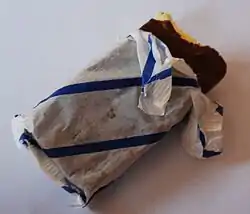Choc ice
A choc ice (British English) or ice cream bar (American English) is a frozen dessert generally consisting of a rectangular block of ice cream—typically vanilla flavour—which is thinly coated with chocolate. Related products may also include other fillings with the ice cream and be styled similar to candy bars. The term has also been used as a racial slur.
 | |
| Course | Dessert |
|---|---|
| Serving temperature | Cold |
| Main ingredients | Ice cream (typically vanilla flavour) chocolate |
Description
A choc ice is a generic frozen dessert generally consisting of a rectangular block of ice cream—typically vanilla flavour—which is thinly coated with chocolate.
History

Ice cream enrobed in chocolate was invented in the 1920s. Confectioner Harry Burt invented the chocolate-enrobed ice cream on a stick in 1920,[1] and was granted a patent in 1923.[2][3] In 1921,[4] the Eskimo Pie chocolate bar was invented in Iowa by a pharmacy owner named Chris Nelson,[5] who was inspired by a boy named Douglas Ressenden who could not decide between candy and ice cream;[6][7] a patent was awarded in 1922, but invalidated in 1928.[6][3] The Klondike bar was also invented in 1922.[8][1][9]
Brands
In many countries, there are numerous versions of this dessert which are produced under many different brand names.
A notable American brand is Klondike,[10][11] which introduced its Klondike bar in the United States in 1922.[12] Related products include frozen confections that enrobe fillings with the ice cream and appear similar to candy bars (e.g., Snickers ice cream bars[13]).
Racial slur
The term choc ice has also become a racial slur used to describe any person who is figuratively "black on the outside, white on the inside".[14][15]
References
- geschenke2015 (8 September 2016). "Ohio's Ice Cream Innovation: The Novelty Bar". dannwoellertthefoodetymologist. Archived from the original on 10 February 2021. Retrieved 24 April 2023.
- "Our History". Good Humor. Archived from the original on 12 August 2020. Retrieved 19 August 2020.
- "Why Ice Cream Soared in Popularity During Prohibition". History.com. 28 January 2021. Archived from the original on 21 February 2023. Retrieved 24 April 2023.
- "The History of Ice Cream". PAPAFiLiPOU.COM. 14 September 2011. Archived from the original on 9 December 2022. Retrieved 24 April 2023.
- "Eskimo Pie Corporation Records | Collection | search=null | SOVA". sova.si.edu. Archived from the original on 25 March 2023. Retrieved 24 April 2023.
- Duan, Charles (20 October 2015). "Ice Cream Patent Headache". Slate. Archived from the original on 18 July 2018. Retrieved 26 October 2017.
- "Eskimo Pies". Archived from the original on 11 July 2007. Retrieved 12 August 2007.
- "Ice Cream History - Discover Amazing Facts and Folklore". Homemade-Dessert-Recipes.com. Archived from the original on 2 December 2022. Retrieved 24 April 2023.
- "In 1922, Klondike bars sold for just 10 cents apiece. They're technically cheaper now". CBS58. Archived from the original on 19 August 2022. Retrieved 24 April 2023.
- "Klondike". klondikebar.com. 17 January 2021. Archived from the original on 15 December 2018. Retrieved 17 January 2021.
- "Klondike introduces the best ice cream bar ever conceived!". unileverusa.com. 14 April 2014. Archived from the original on 22 January 2021. Retrieved 16 January 2021.
- Butko, Brian. Klondikes, Chipped Ham, & Skyscraper Cones: The Story of Isaly’s. Stackpole Books (July 2001). ISBN 0-8117-2844-7
- "Snickers JUST Dropped NEW Peanut Brownie Ice Cream Bars, and We've Already Got a Craving". Taste of Home. 15 December 2020. Archived from the original on 18 January 2022. Retrieved 19 April 2023.
- "Rio Ferdinand claims 'choc ice' term is common slang, not racist". The Guardian. 15 July 2012. Archived from the original on 14 February 2021. Retrieved 12 January 2021.
- "Detective faces racism allegations after reportedly describing a BAME colleague as a "choc ice"". Yorkshire Post. 9 December 2020. Archived from the original on 14 December 2020. Retrieved 14 December 2020.